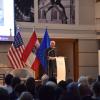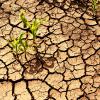
A major qualitative and quantitative step-change is needed in science to support critical societal transformations towards a more sustainable, equitable, and resilient future. IIASA Director General Albert van Jaarsveld contributed to a new report published by the International Science Council (ISC), advocating for a concerted effort by the global science community to step up to the challenge.
With just nine years to achieve the 2030 Agenda with its 17 Sustainable Development Goals (SDGs), all countries and actors need to urgently intensify efforts and realign their priorities and resources towards longer-term, more collaborative, and drastically accelerated action. Achieving the transformative vision of the SDGs by 2030 is also the most pressing challenge for science, requiring game-changing collective action within science systems and funding globally.
The report Unleashing Science: Delivering Missions for Sustainability offers an ambitious approach – a concerted effort to produce actionable knowledge through a set number of Sustainability Science Missions in the critical areas of food, energy and climate, health and wellbeing, water, and urban areas. Scaling up science investment to strongly and sustainably support Sustainability Science Missions united around a common sustainability agenda, provides a real opportunity for mobilizing and putting to use the best global science for societal transformations in an outcome-driven, coordinated, and integrated manner.
“Delivering on the SDGs is a global humanitarian imperative and the collective sciences have much to offer to make this possible. The mission challenge is to harness scientific capabilities to overcome societal obstacles that prevent us from achieving a dignified future for all of humanity,” says IIASA Director General Albert van Jaarsveld, who contributed to the report as a member of the Global Forum of Funders.
Delivering the Sustainability Science Missions will require broad and bold engagement and commitment, from science funders, but also from decision makers and influencers in governments, the private sector, and in civil society. The international funding community is ready for the challenge and has tasked the International Science Council with leading the development of a process to convene the necessary voices, jointly designing the way forward. This report is an input into that process. It is intended to challenge and – where necessary – to disrupt current ways of thinking and to inspire ambitious and achievable outcomes.
“For the International Science Council, the biggest and most urgent challenge for contemporary science is to identify pathways to global sustainability, and to assist in the creation and promotion of policies and public action that can advance societies along those pathways. The Council is committed to mobilizing the enabling conditions and resources needed to secure impactful global action in response to this challenge. The time to act is now,” notes ISC Chief Executive Officer Heide Hackmann.
The report presents a framework of ideas on how science, along with science funders, policymakers, civil society, and the private sector, could rise to the challenge of acting effectively in the face of urgent and existential risks to humanity. For science to unleash its full promise, it must be focused, shielded, and continually and substantially supported and promoted – both financially and politically – like the mission to the Moon. Ensuring an equal opportunity for a safe and dignified future for humanity should be worthy of a similar commitment.
Along with the ISC and other partners, IIASA is committed to working with political leaders, science funders ̶ both national and philanthropic ̶ and development aid agencies to identify the most appropriate institutional arrangements and funding mechanisms required to co-construct and deliver on the Sustainability Science Missions. Join us in empowering mission-oriented science for sustainable societal transformations in the 21st century.
Adapted from an original posting by the International Science Council. Read the original post here.
Further info
Click here to download the full report
News

14 June 2024
IIASA Leadership visits Washington DC

05 June 2024
The 2024 State of CDR Report: Scaling up CO2 removal to meet Paris Targets

25 April 2024
